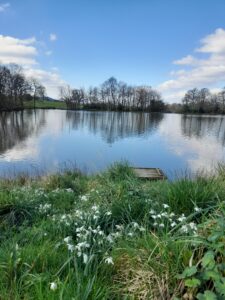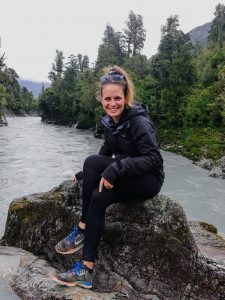by
Helena Darragh
29th April 2022
It’s been a busy year but we have some great things happening across Cranborne Chase
Farming in Protected Landscapes is a Defra funded programme running until March 2024 to provide support to land managers in AONBs and National Parks across England.

Projects are supporting nature’s recovery, mitigating the impacts of climate change, providing opportunities for people to discover, enjoy and understand the landscape and its cultural heritage, and protecting the quality and character of this special landscape.
Here in Cranborne Chase we’ve had some great projects and more are underway and we summarise a few of these here:

Down Farm – natural scrub regeneration and helping the greater butterfly-orchid
450 hawthorn, buckthorn, spindle and guelder rose saplings were planted to buffer and extend existing scrub habitat, also offering protection to a newly created pond. The scrub was planted fairly densely and non-uniformly (1 every 1.5m over 85% of the area) to create natural-looking scrub conditions suited for nightingale and turtle dove.
‘Scrubbing-up’ this section provides habitat connectivity from the existing scrub section and offers more cover to a range of birds, invertebrates and small mammals present on the site, attracted to the nearby pond and exposed chalk. Carbon will be stored through the increased trees being planted, landscape more resilient through more connected and buffered scrub habitats and pond. Maps and species surveys (birds, dragonflies, insects) carried out during the Farming in Protected Landscapes Programme will show area increase in wildlife rich scrub habitat and biodiversity, also improving the management of existing habitat.
Other areas of the farm are undergoing natural scrub regeneration on chalkland so this project offered a good opportunity to assess the success of manual creation of this habitat, whilst speeding up natural process to better protect habitat and pond from surrounding arable fields.
Fencing protection has also been offered to a small area of greater butterfly-orchid discovered on another patch of mature managed scrub on the farm holding. Having noticed that these rare plants are being grazed by rabbits, rabbit fencing a small section of this scrub area, where the greater butterfly-orchids are most prolific, will prevent the grazing of these near threatened orchids and better enable the monitoring of their spread going forward.
Cranborne Chase Farm Cluster – training, surveys and habitat creation
 Funding has also been awarded to the Cranborne Chase Farmer Cluster with a range of capital items, training, surveys and habitat creation. 12 Barn owl boxes and 21 swift boxes were installed across the cluster to provide additional nest sites. Small mammal tunnels have been installed on two farms, who will carry out a 1km square hedgehog survey in the spring when the survey season starts. Farmers will receive training on how to identify the footprints of mammals using these tunnels to better monitor species on farms. The tunnels will be circulated round farmers in the cluster after the current survey season and knowledge on how to identify species shared between farmers to increase learning. One farm has set up tunnels with school groups as part of the farm’s educational access offer. 31 bat boxes have been bought and are being put up across the cluster area.
Funding has also been awarded to the Cranborne Chase Farmer Cluster with a range of capital items, training, surveys and habitat creation. 12 Barn owl boxes and 21 swift boxes were installed across the cluster to provide additional nest sites. Small mammal tunnels have been installed on two farms, who will carry out a 1km square hedgehog survey in the spring when the survey season starts. Farmers will receive training on how to identify the footprints of mammals using these tunnels to better monitor species on farms. The tunnels will be circulated round farmers in the cluster after the current survey season and knowledge on how to identify species shared between farmers to increase learning. One farm has set up tunnels with school groups as part of the farm’s educational access offer. 31 bat boxes have been bought and are being put up across the cluster area.
Farm Carbon Toolkit (FCT) training was provided to the cluster and was well attended with 13 cluster members representing 11 cluster farms attending. FCT helps provide a better understanding among farmers on how they can reduce carbon emissions across their farm business. Feedback completed after the event showed that 100% of respondents will be completing the FCT for their farm and two-thirds will be making management changes as a result. Two farmers had follow-up 1:1 sessions with a FCT adviser to complete the toolkit. One is a farm that is going organic this year which will provide some interesting comparison. Others feel confident to complete it themselves.

Related to carbon, 76 soil samples have been taken by the farmers themselves. Augers (drills for making holes in the ground) were shared among the cluster members and this has worked well. Results will be collated and shared as soon as they are back from the laboratory. The importance of soil in sequestering and storing carbon has become increasingly widespread. The results of the sampling will provide a baseline across holdings to feed into the FCT calculations and measure improvements going forwards as farmers look to move towards more regenerative farming principles delivering results for nature and climate.
Supported farmers planting almost 2km of hedgerows as part of the Close the Gap Hedgerows Project by protecting these young trees to give better chance of success.
3.2ha of arable land was cultivated in March 2022 as plots for arable plants. These areas have been targeted at three farms following post 1990 and 2010 survey records of listed plants falling in Important Arable Plant Areas as recorded by Plantlife. They will be surveyed in August 2022 and results will be shared.
Botleys Farm – lapwing plots, owl and kestrel boxes
-
- A 5ha lapwing plot was created in the middle of an open and expansive arable field, where lapwing

Lapwing plot in Cranborne Chase AONB have been previously sighted by the farmer. The plot will be maintained by the farmer through support from FiPL and looked to be continued in a stewardship agreement. We’re really looking forward to seeing the results of the creation of this habitat over the coming years of FiPL.
- We also supported the gapping-up, planting and protection of hedges and trees across the holding, helping to capture carbon and improve the connectivity of environmental features to enable species to travel through the farm easily. Two owl boxes, two kestrel boxes and one little owl box have also been installed by tussocky grassland areas on the farm and the farmer will be reporting back on their use over the coming years.
- A 5ha lapwing plot was created in the middle of an open and expansive arable field, where lapwing

Wardour Castle Estate – restoring Swan Pond and creation of swales to prevent flooding
Farming in Protected Landscapes is helping to fund a programme of works at the Wardour Estate to restore elements of its original design
The work at Wardour includes tree clearance on the dam at Park Pond, the final pond in the chain of lakes that starts at the A30. It was designed originally to be a visible, eye-catching water feature that you would see from other areas of the Estate. This clearance will also make way for an improved public footpath making it a much easier place to access and enjoy. The second element is the restoration of the tail of Swan Pond, the pond designed in the shape of a pond is near the parking area at Old Wardour Castle. It is hoped that future funding may pay for a footpath for buggies and wheelchairs which will go along to the corner of the pond, and new benches so people can enjoy the view and see the gothic pavilion.
Feasibility Studies
FiPL has supported the creation of plans for future habitat connectivity and improvement work on the Wylye Valley Farmer Group, with the GWCT to create a new Environmental Farmers Group joining a number of farm clusters in Cranborne Chase AONB and New Forest National Park.
Surveys and studies are also being carried out during the spring and summer 2022 on council farms, individual land holdings and estates across the AONB to inform future work to improve farmland for nature.

Helena Darragh is the Farming in Protected Landscapes Officer at Cranborne Chase AONB.
The Farming in Protected Landscapes team is always here to help and welcomes informal chats about any ideas you may have. Get in touch with Helena here or find out more on our dedicated webpage:
Helena Darragh – Cranborne Chase AONB

